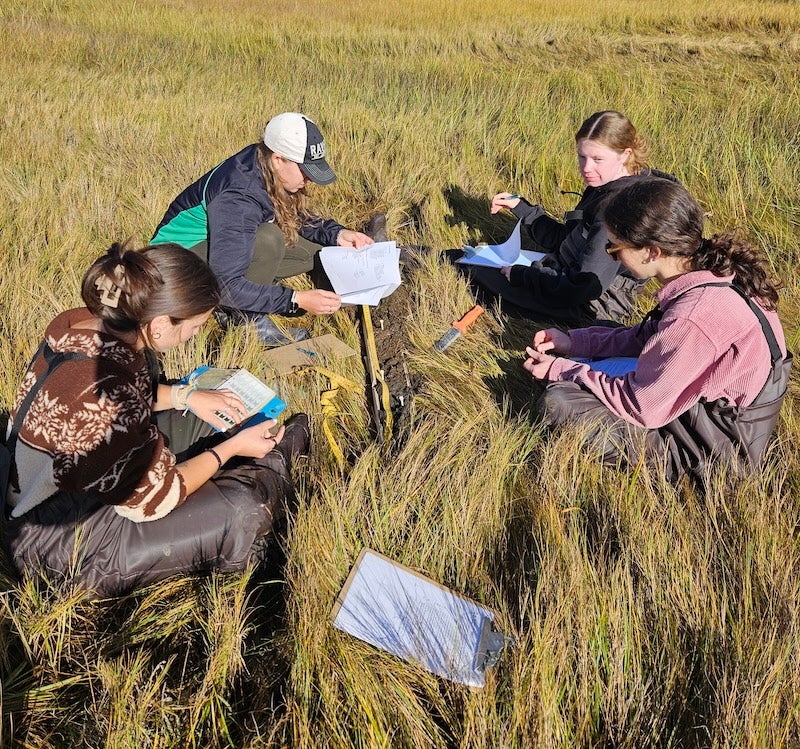Michelle Peach, clinical assistant professor and program coordinator for the Master of Environmental Science and Management (MESM) program, has taught and/or designed at least 15 different courses in her time at URI. These include large introductory courses, field-based lab classes, graduate seminars, and accelerated online courses. This school year she is teaching NRS 423: Wetland Ecology, NRS 223: Conservation Biology, NRS 200: Seminar in Natural Resources, EVS 501: Development of Learning Outcomes for MESM, and EVS 502: Seminar in Environmental Science and Management. She is passionate about immersing students in the natural sciences and helping them develop personal connections to the natural world.
Q. Describe one of your most memorable teaching experiences.

A. Every year I take my wetland ecology students out to a site in the Carolina Management area that is very challenging to reach. Students have to walk through chest deep water over sticky mud mixed with hidden logs threatening to trip them at each step. To finally reach the site, they have to avoid a deep pool (someone gets water over their waders every year) and literally haul themselves up on a mat of sphagnum. For some students it is a fun adventure, but for others it is an intense physical and mental challenge. When we finally emerge onto a floating bog that moves up and down under our feet, we get to see very cool carnivorous plants adapted to living in these low-nutrient environments, and sometimes, if we’re very lucky, we are able to harvest and eat wild cranberries! Everyone agrees it was worth the effort to get out there. I love it because students are so completely immersed in the experience. They not only learn about the ecology of bogs, but they also develop a personal connection to the site and their classmates who support them through the long slog to get there and back.

What is one lesson you hope your students take away from your courses besides the content being covered?
In my content-based classes, wetland ecology and conservation biology, I hope students learn to see the natural world in new and interesting ways and that they develop a stronger personal connection to the natural world.
What has been the most surprising or unexpected part of teaching?
Honestly, I am always surprised by the new challenges that arise. After teaching for several years, I feel like I should have run into the whole range of things that can come up in my life, my students’ lives, or in URI logistics that have the potential to impede effective teaching and learning. Every year, though, I run into some new challenge that needs to be addressed, whether that is a student with a particular set of physical challenges that need to be accommodated in a field lab, inclement weather, equipment malfunction, etc. It keeps me on my toes. There is no such thing as reaching the point in teaching where you can run on cruise control.
Who was the most inspiring teacher in your life and why?
My high school biology teacher and my high school English teacher both stand out as excellent role models. Both of them were passionate about their subject matter and, more importantly for me at the time, they were also passionate about their students. They challenged us to grow and learn. They didn’t make learning easy, but they did make sure we knew they were there to support us as we went through the mix of failure and success that are essential to the learning process.
How do you incorporate hands-on learning into your courses?
This varies a lot depending on the class. I love teaching field labs where hands-on learning is foundational to the class. For wetland ecology, we spend two hours a week in a classroom and four hours a week out interacting with the natural world – identifying plants, describing soils, collecting aquatic invertebrates, classifying wetland types, etc. Field labs are immersive experiences and powerful learning opportunities. It is more challenging to incorporate hands-on learning into large lecture classes, but it is still important to find ways to encourage students to actively engage with course material rather than passively listening. In Conservation Biology (~120 students) I try to use a variety of techniques to promote student engagement, including interactive software that allows students to respond to questions/activities in real time, old school problems for students to solve on their own or in small groups using pen and paper, group projects, small and large group conversations, etc.
Why do you think it’s important to teach about wetland ecology?
I was inspired to enter this field because of the challenges facing human communities, cultures and lives around the world as a result of ecological degradation and loss. I am not naïve enough to think I can “save the world”, but I do think that we as a society have to continue searching for ways to address challenges like climate change, biodiversity loss, water shortages, etc. These could all become existential threats. I think everyone should have a basic understanding of ecology and the ways human activities affect the natural world because we are all a part of the natural world.
Want to nominate a professor or faculty member for their excellence in engaging, innovative teaching? Contact us at cels-info@etal.uri.edu.

